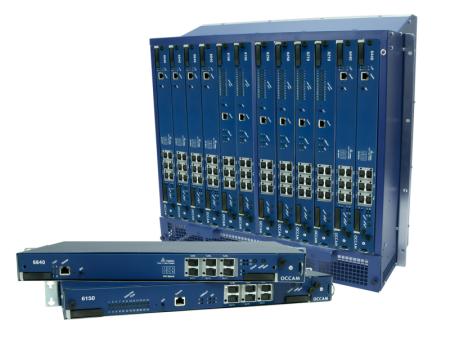Device Profile: Occam BLC 6000 broadband loop carrier chassis
Jul 13, 2004 — by LinuxDevices Staff — from the LinuxDevices Archive — 75 viewsOccam Networks used embedded Linux in what it calls the first broadband loop carrier (BLC) device with a Gigabit Ethernet transport. The company says it chose Linux for its BLC 6000 due to driver quality. The BLC 6000 targets DSL, video, voice, and “triple play” service providers offering all three.

The BLC 6xxx family includes low and high-density devices
(Click to enlarge)
What'll she do?
According to Occam, the BLC 6000 can deliver simultaneous voice, video, and high-speed data services to residential and business subscribers, using Ethernet and Internet Protocol (IP) as the core transport and service protocols, instead of expensive ATM or SONET found in legacy devices. The device's scalable Ethernet trunking obviates the need for DSLAMs (digital subcriber line access multiplexers), which are the devices typically installed at phone company facilities to agglomerate multiple DSL lines into a single ATM trunk. The device also eliminates Ethernet switches, OADMs (optical add drop multiplexers), and VoIP (voice over IP) gateways, the company claims.
The BLC 6000 chassis is environmentally hardened, and suitable for use in remote, harsh environments. It is available in a single 1U chassis for low-density applications, or in a 12U high-density chassis, also available for 19-inch racks. All configurations use the same “Intelligent Blade Interconnect Architecture,” which Occam says overcomes the disadvantages of backplanes. Occam hopes flexible deployment options using the same basic units will inspire companies to standardize on the device for both home and remote offices.
The device supports both copper and fiber terminals, providing a smooth upgrade path. It can support between 24 and “thousands” of DSL subscribers, Occam says.
The BLC 6000 can be used to deliver a wide range of subscriber services, including lifeline POTS (plain old telephone service), T1/E1, high-density ADSL, and ADSL2Plus, a kind of DSL service supporting multiple line bonding for “triple play” services including HD TV. And, an optional central office terminal can terminate voice services via TR-08 or GR-303 Class 5 switch interfaces.
The device supports redundant GigE lines between central and home offices. It also offers legacy ATM and Sonet interfaces, and has optical GigE service ports for advanced subscriber services. Supported advanced services include:
- SHDSL, or single pair high-speed DSL, which provides symmetric (equal upstream and downstream speeds) services up to 2.4Mbps over a single pair of twisted copper wires.
- VDSL, or very high-speed DSL, which can deliver 13-55Mbps speeds at distances between 1,000 and 4,500 feet of twisted pair copper wire.
- FTTH, or fiber to the home
The BLC 6000 supports softswitch platforms using native mode MGCP (media gateway control protocol) signaling, with H.248 protocol support pending. It also supports VoIP services such as IP Centrex delivered to traditional telephones.
Software side
On the software side, the BLC 6000 offers a configuration and management interface that supports alarm processing, policy management, service management, service activation, software imaging, and configuration management.
Occam claims that “Ethernet protection switching” enables the device to fail over in the event of link or node failure in less than 50 msec, providing “the resiliency of SONET” without SONET's ring limitations. The switching technology supports dozens of nodes on a single ring, as well as string, star, and tree network configurations.
The BLC 6000 offers QoS (quality of service) features based on standard Linux IP and Ethernet QoS protocols — traditionally deemed too complex to manage in telecom applications. Occam says its service-class management tools reduce the complexity of Ethernet QoS management, at least when used only on the local loop, and that the device delivers outstanding voice and video quality “at all load levels.”
Why Linux?
Occam says it chose Linux because the availability of drivers that “just worked” and other off-the-shelf components. The company considered proprietary RTOSes and in-house Linux implementations before deciding to use a commercially supported version of Linux, a decision it felt ultimately saved money and development time.
The company chose MontaVista Linux because it supported all hardware platforms being evaluated, and came with commercial-grade software development tools. Additionally, drivers supplied by third parties ran on MontaVista without additional work.
Occam reports satisfaction with the choice to use MontaVista Linux, claiming that the OS and tools offered enough flexibility to work well with their custom applications, which have strict requirements.
“Telephone companies are shifting to a Broadband IP delivery model for all of their services,” noted Occam Marketing VP Kris Sowolla.
MontaVista VP of Strategic Operations Kelly Herrell added, “Linux has strong networking capabilities, tremendous flexibility, and a high level of service reliability.”
This article was originally published on LinuxDevices.com and has been donated to the open source community by QuinStreet Inc. Please visit LinuxToday.com for up-to-date news and articles about Linux and open source.